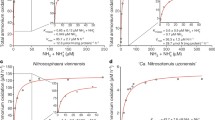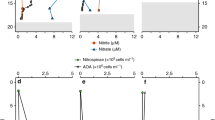Abstract
In pure culture, the marine ammonia oxidizer,Nitrosococcus oceanus, exhibits normal Michaelis Menten kinetics with respect to its primary substrate, ammonia.N. oceanus also exhibits a kinetic response to methane. In the absence of methane, oxidation of ammonia is first order with respect to ammonia concentration under atmospheric oxygen concentrations at seawater pH. In the presence of methane, ammonia oxidation is inhibited, and the amount of inhibition is related to the relative concentrations of methane and ammonia. Using semicontinuous batch cultures as a source of organisms for short-term kinetic experiments, I investigated the relationship between ammonia and methane oxidation inN. oceanus by varying the absolute and relative concentration of both substrates. Methane appeared to act as a substrate analogue, and its effect on ammonia oxidation was modeled as a permutation of competitive inhibition involving a cooperative enzyme system. Methane was oxidized byN. oceanus, even in the absence of measurable ammonia oxidation, but the process was inhibited at increasing methane concentrations. Of the two product pools analyzed, an average of 37% of methane oxidized was detected in particulate (cell) material and the remainder was detected in14CO2. The contribution of methane to total carbon assimilation varied with the ratio [CH4]/[NH3] and may be significant under substrate concentrations typical of a dilute aquatic environment.
Similar content being viewed by others
References
Anthony C (1982) The biochemistry of methylotrophs. Academic Press, London
Button DA (1985) Kinetics of nutrient-limited transport and microbial growth. Microbiol Rev 49:270–297
Bzrezinski MA (1987) Colorimetric determination of nanomolar concentrations of ammonium in seawater using solvent extraction. Mar Chem 20:277–288
Bzrezinski MA (1988) The vertical distribution of ammonium and nitrite in stratified oligotrophic waters. Limnol Oceanogr 33:1176–1182
Carlucci AF, Pramer D (1957) Factors influencing the plate method for determining abundance of bacteria in sea water. Proc Soc Exp Biol Med 96:392–394
Changeux J-P, Gerhart JC (1968) Allosteric interactions in aspartate transcarbamylase. In: Changeux J-P, Kvamme E, Phil A (eds) Regulation of enzyme activity and allosteric interactions. Academic Press, London, pp 13–38
Conrad R (1984) Capacity of aerobic microorganisms to utilize and grow on atmospheric trace gases (H2, CO, CH4). In: Klug MJ, Reddy CA (eds) Current perspectives in microbial ecology. Amer Soc Microbiol, Washington, DC, pp 461–467
Daniels L, Zeikus JG (1983) Convenient biological preparation of pure high specific activity14C-labelled methane. J Labelled Comp Radiopharm 20:17–24
Glover HE (1985) The relationship between inorganic nitrogen oxidation and organic carbon production in batch and chemostat cultures of marine nitrifying bacteria. Arch Microbiol 142:45–50
Hooper AB (1984) Ammonia oxidation and energy transduction in the nitrifying bacteria. In: Strohl WR, Tuovinen OH (eds) Microbial chemoautotrophy. The Ohio State University Press, Columbus, pp 134–167
Hyman MR, Wood PM (1983) Methane oxidation byNitrosomonas europaea. Biochem J 212:31–37
Jones RD, Morita RY (1983) Methane oxidation byNitrosococcus oceanus andNitrosomonas europaea. Appl Environ Microbiol 45:401–410
Krummel A, Harms H (1982) Effect of organic matter on growth and cell yield of ammonia-oxidizing bacteria. Arch Microbiol 133:50–54
Koroleff F (1983) Determination of nutrients. In: Grasshoff K, Ehrhardt M, Kremling K (eds) Methods of seawater analysis. Verlag Chemie, New York, pp 125–187
Neet KE (1983) Cooperativity in enzyme function: Equilibrium and kinetic aspects. In: Purch DL (ed) Contemporary enzyme kinetics and mechanism. Academic Press, Orlando, pp 267–320
Nissen H, Nissen P, Azam F (1984) Multiphasic uptake of D-glucose by an oligotrophic marine bacterium. Mar Ecol Prog Ser 16:155–160
Scranton MI, Brewer PG (1977) Occurrence of methane in the near-surface waters of the western subtropical North-Atlantic. Deep-Sea Res 24:127–138
Shears JH, Wood PM (1985) Spectroscopic evidence for a photosensitive oxygenated state of ammonia mono-oxygenase. Biochem J 226:499–507
Smith GD, Roberts DV, Kuchel PW (1975) Active site directed effectors of allosteric enzymes. Biochim Biophys Acta 377:197–202
Strickland JDH, Parsons TR (1972) A practical handbook of seawater analysis. Bull Fish Res Bd Can 67, 2nd ed, Ottawa, Canada, pp 1–310
Stumm W, Morgan JJ (1981) Aquatic chemistry. John Wiley & Sons, New York
Suzuki I, Dular U, Kwok S-C (1974) Ammonia or ammonium ion as substrate for oxidation byNitrosomonas europaea cells and extracts. J Bacteriol 120:556–558
Suzuki I, Kwok S-C, Dular U (1976) Competitive inhibition of ammonia oxidation inNitrosomonas europaea by methane carbon monoxide or methanol. FEBS Lett 72:177–120
Suzuki I, Kwok S-C (1981) A partial resolution and reconstitution of the ammonia-oxidizing system ofNitrosomonas europaea: Role for cytochrome c554. Can J Biochem 59:484–488
Suzuki I, Kwok S-C, Dular U, Tsang DCY (1981) Cell-free ammonia-oxidizing system ofNitrosomonas europaea: General conditions and properties. Can J Biochem 59:477–483
Tsang DCY, Suzuki I (1982) Cytochrome c554 as a possible electron donor in the hydroxylation of ammonia and carbon monoxide inNitrosomonas europaea. Can J Biochem 60:1018–1024
Voysey PA, Wood PM (1987) Methanol and formaldehyde oxidation by an autotrophic nitrifying bacterium. Jour Gen Microbiol 133:283–290
Ward BB (1987) Kinetic studies on ammonia and methane oxidation byNitrosococcus oceanus. Arch Microbiol 147:126–133
Ward BB, Kilpatrick KA, Novelli PC, Scranton MI (1987) Methane oxidation and methane fluxes in the ocean surface layer and deep anoxic waters. Nature 327:226–229
Watson SW, Asbell MA, Valois FW (1970) Ammonia oxidation by cell-free extracts ofNitrosocystis oceanus. Biochem Biophys Res Comm 38:1113–1119
Whittenbury R, Kelly DP (1977) Autotrophy: A conceptual phoenix. In: Haddock BA, Hamilton WA (eds) Microbial energetics. Symposia of the Society for General Microbiology, 27, Cambridge University Press, London, pp 121–149
Williams PJLeB, Watson SW (1968) Autotrophy inNitrosocystis oceanus. Jour Bacteriol 96:1640–1648
Yamamoto S, Alcauskas JB, Crozier TE (1976) Solubility of methane in distilled water and seawater. Jour Chem Eng Data 21:78–80
Zehnder AJB, Huser B, Brock TD (1979) Measuring radioactive methane with the liquid scintillation counter. Appl Environ Microbiol 5:897–899
Author information
Authors and Affiliations
Rights and permissions
About this article
Cite this article
Ward, B.B. Kinetics of ammonia oxidation by a marine nitrifying bacterium: Methane as a substrate analogue. Microb Ecol 19, 211–225 (1990). https://doi.org/10.1007/BF02017166
Issue Date:
DOI: https://doi.org/10.1007/BF02017166




